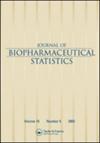On improving the accuracy of prediction in Cox models for failure times using copulas.
IF 1.2
4区 医学
Q4 PHARMACOLOGY & PHARMACY
引用次数: 0
Abstract
The conventional Cox proportional hazards model is designed to measure the influence of factors on the timing of an event and focuses more on relative risk rather than absolute risk. In the presence of multiple time-to-event variables, this study introduces a copula-based extension of the standard Cox model, which facilitates the dependence structure between variables. We employ vine copulas to effectively model the potentially non-linear relationships between failure times. Through conducting simulation studies, we show that our new algorithm greatly improves the accuracy of predicting failure times compared to other existing methodologies. Our findings are applied to predict mortality timing in real medical data.
利用copula提高Cox模型失效时间预测的准确性。
传统的Cox比例风险模型旨在衡量因素对事件发生时间的影响,并且更多地关注相对风险而不是绝对风险。在存在多个时间到事件变量的情况下,本文引入了基于copula的标准Cox模型的扩展,简化了变量之间的依赖结构。我们使用vine copula来有效地模拟故障时间之间潜在的非线性关系。通过仿真研究,我们表明,与其他现有方法相比,我们的新算法大大提高了预测故障时间的准确性。我们的发现被应用于预测真实医疗数据中的死亡时间。
本文章由计算机程序翻译,如有差异,请以英文原文为准。
求助全文
约1分钟内获得全文
求助全文
来源期刊

Journal of Biopharmaceutical Statistics
医学-统计学与概率论
CiteScore
2.50
自引率
18.20%
发文量
71
审稿时长
6-12 weeks
期刊介绍:
The Journal of Biopharmaceutical Statistics, a rapid publication journal, discusses quality applications of statistics in biopharmaceutical research and development. Now publishing six times per year, it includes expositions of statistical methodology with immediate applicability to biopharmaceutical research in the form of full-length and short manuscripts, review articles, selected/invited conference papers, short articles, and letters to the editor. Addressing timely and provocative topics important to the biostatistical profession, the journal covers:
Drug, device, and biological research and development;
Drug screening and drug design;
Assessment of pharmacological activity;
Pharmaceutical formulation and scale-up;
Preclinical safety assessment;
Bioavailability, bioequivalence, and pharmacokinetics;
Phase, I, II, and III clinical development including complex innovative designs;
Premarket approval assessment of clinical safety;
Postmarketing surveillance;
Big data and artificial intelligence and applications.
 求助内容:
求助内容: 应助结果提醒方式:
应助结果提醒方式:


